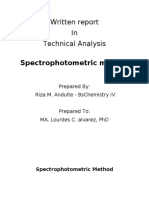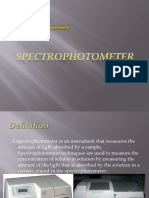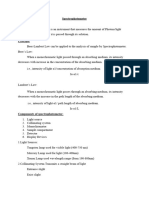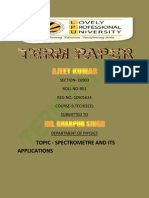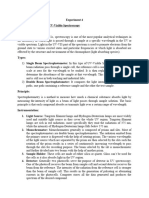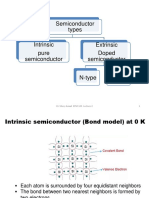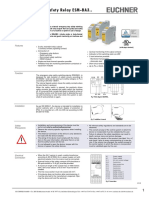SPECTROS
SPECTROS
Uploaded by
uthmanabdulazeez12Copyright:
Available Formats
SPECTROS
SPECTROS
Uploaded by
uthmanabdulazeez12Original Title
Copyright
Available Formats
Share this document
Did you find this document useful?
Is this content inappropriate?
Copyright:
Available Formats
SPECTROS
SPECTROS
Uploaded by
uthmanabdulazeez12Copyright:
Available Formats
SPECTROSCOPY
The study of the interaction between matter and electromagnetic radiation
It is the term used to refer to the measurement of radiation intensity as a function of
wavelength.
Often use to describe experimental spectroscopic methods.
Four different spectroscopic techniques are commonly used and this include
1. Ultraviolet-visible spectroscopy
2. Infrared spectroscopy
3. Nuclear magnetic resonance spectroscopy (NMR)
4. Mass spectrometry.
The first three are known as absorption spectroscopy
Spectral measurement devices are referred to as spectrometers, spectrophotometers,
spectrographs or spectral analyzers.
Spectrophotometers
A spectrophotometer is an instrument that measures the amount of light absorbed by a
sample.
Spectrophotometer techniques are mostly used to measure the concentration of solutes in
solution by measuring the amount of the light that is absorbed by the solution in a cuvette
placed in the spectrophotometer.
Scientist Arnold J. Beckman and his colleagues at the National Technologies Laboratory
(NTL) invented the Beckman DU spectrophotometer in 1940.
Principle of Spectrophotometer
The spectrophotometer technique is to measure light intensity as a function of wavelength. It
does this by diffracting the light beam into a spectrum of wavelengths, detecting the intensities
with a charge-coupled device, and displaying the results as a graph on the detector and then on
the display device.
1. A sample solution is placed inside the spectrophotometer.
2. A light source shines light toward the sample.
3. A device called a monochromator splits the light into each color, or rather, individual
wavelengths (just like a raindrop makes a rainbow). An adjustable slit allows only one
specific wavelength of light through to the sample solution.
4. The wavelength of light hits the sample, which is held in a little container called a
cuvette. We need to be careful when handling cuvettes; even a slight fingerprint can
interfere with the results.
5. Whatever light passes through the sample is read and displayed on the output screen.
Instrumentation of Spectrophotometer
The essential components of spectrophotometer instrumentation include:
1. A table and cheap radiant energy source
Materials which can be excited to high energy states by a high voltage electric discharge
(or) by electrical heating serve as excellent radiant energy sources.
2. A monochromator, to break the polychromatic radiation into component wavelength
(or) bands of wavelengths.
A monochromator resolves polychromatic radiation into its individual wavelengths and
isolates these wavelengths into very narrow bands. It could be prism (or) grating.
PRISMS:
A prism disperses polychromatic light from the source into its constituent wavelengths by
virtue of its ability to reflect different wavelengths to a different extent
Two types of Prisms are usually employed in commercial instruments. Namely,
600 cornu quartz prism and 300 Littrow Prism.
GRATINGS:
Gratings are often used in the monochromators of spectrophotometers operating
ultraviolet, visible and infrared regions.
3. Transport vessels (cuvettes), to hold the sample
Samples to be studied in the ultraviolet (or) visible region are usually glasses (or)
solutions and are put in cells known as “CUVETTES”.
Cuvettes meant for the visible region are made up of either ordinary glass (or) sometimes
Quartz.
4. A Photosensitive detector and an associated readout system
Most detectors depend on the photoelectric effect. The current is then proportional to the
light intensity and therefore a measure of it.
Radiation detectors generate electronic signals which are proportional to the transmitter
light.
These signals need to be translated into a form that is easy to interpret.
This is accomplished by using amplifiers, Ammeters, Potentiometers and Potentiometric
recorders.
Measuring Absorbance
The amount of light that makes it through the substance is displayed on the output screen and is
called absorbance. In order for this number to mean anything, we need a standard curve. A
standard curve is determined by recording the absorbance of known concentrations of a
material.
Applications of Spectrophotometer
Some of the major applications of spectrophotometers include the following:
Detection of concentration of substances
Detection of impurities
Structure elucidation of organic compounds
Monitoring dissolved oxygen content in freshwater and marine ecosystems
Characterization of proteins
Detection of functional groups
Respiratory gas analysis in hospitals
Molecular weight determination of compounds
The visible and UV spectrophotometer may be used to identify classes of compounds in
both the pure state and in biological preparations.
You might also like
- SpectrophotometryDocument5 pagesSpectrophotometryKashifntcNo ratings yet
- Philips Ps-424-Ph Lj44-00101c Psu Repair-Tips (ET)Document76 pagesPhilips Ps-424-Ph Lj44-00101c Psu Repair-Tips (ET)demate0% (1)
- Dp2-Eee54 Haji MohamadDocument3 pagesDp2-Eee54 Haji MohamadAmirah Haji MohamadNo ratings yet
- Spectrophotometer-Principle, Instrumentation, Applications: What Is A Spectrophotometer?Document2 pagesSpectrophotometer-Principle, Instrumentation, Applications: What Is A Spectrophotometer?Talhas Production100% (1)
- 88Document57 pages88Nilesh MaitiNo ratings yet
- BCH 315 First Lecture NoteDocument12 pagesBCH 315 First Lecture Notemichaelokuchukwu22No ratings yet
- Spectrophotometer Mls 3rdDocument14 pagesSpectrophotometer Mls 3rdRuhulla AbbassNo ratings yet
- Report Ni RizaDocument8 pagesReport Ni RizaInga Budadoy NaudadongNo ratings yet
- Spectro Photo Me TryDocument8 pagesSpectro Photo Me Trysushil4056No ratings yet
- tmp3588122518401173628 PrintDocument25 pagestmp3588122518401173628 Printjosephusjohn009No ratings yet
- Photo MeterDocument4 pagesPhoto MeterRKMNo ratings yet
- SpectrophotometryDocument7 pagesSpectrophotometrySantanah Daxene DayloNo ratings yet
- Anachem Group 3 SpectrosDocument15 pagesAnachem Group 3 SpectrosApufwplggl JomlbjhfNo ratings yet
- What Is A Spectrophotometer?: ApparatusDocument2 pagesWhat Is A Spectrophotometer?: ApparatusSambhav ChaturvediNo ratings yet
- Org ChemDocument8 pagesOrg ChemAnam MustafaNo ratings yet
- Topic - Spectrometre and Its Applications: SECTION-C6903 Roll No-B51 REG NO.-10901624 Course-B.Tech (Ece) Submitted ToDocument20 pagesTopic - Spectrometre and Its Applications: SECTION-C6903 Roll No-B51 REG NO.-10901624 Course-B.Tech (Ece) Submitted ToNimit ChauhanNo ratings yet
- Ultra Violet - Visible SpectrosDocument13 pagesUltra Violet - Visible SpectrosSherin SunnyNo ratings yet
- Spectro Photo Me TryDocument5 pagesSpectro Photo Me Trykapil sharmaNo ratings yet
- SPECTROPHOTOMETERDocument5 pagesSPECTROPHOTOMETERKokab KhanNo ratings yet
- Assignment Spectrophotometer ModernDocument21 pagesAssignment Spectrophotometer ModernBaim Black RushNo ratings yet
- Veer Chandrasingh Garhwali Uttarakhanduniversity of Horticulture and ForestryDocument6 pagesVeer Chandrasingh Garhwali Uttarakhanduniversity of Horticulture and ForestrySimranNo ratings yet
- How Does A Spectrophotometer WorkDocument10 pagesHow Does A Spectrophotometer WorkDuc Nguyen ManhNo ratings yet
- Lec. 6 To 7 Spectroscopy-2Document37 pagesLec. 6 To 7 Spectroscopy-2smo869957No ratings yet
- Research On The Instrumental Designs of Spectrophotometrer-2Document20 pagesResearch On The Instrumental Designs of Spectrophotometrer-2silvyas.abdalshahedNo ratings yet
- Principle: Visible and Ultraviolet (Uv) SpectrosDocument10 pagesPrinciple: Visible and Ultraviolet (Uv) SpectrosKalyanNo ratings yet
- The Principle of A UV SpectrometerDocument4 pagesThe Principle of A UV SpectrometerVignesh AmrNo ratings yet
- Spectrophotometry: UV-visible Spectrophotometer: Uses Light Over The Ultraviolet Range (185Document3 pagesSpectrophotometry: UV-visible Spectrophotometer: Uses Light Over The Ultraviolet Range (185azeem999No ratings yet
- COLORIMETRYDocument8 pagesCOLORIMETRYbehappykoo1997No ratings yet
- Color Wavelength NM Violet Blue Cyan Green Yellow Orange RedDocument4 pagesColor Wavelength NM Violet Blue Cyan Green Yellow Orange RedJhenard John Lansangan BeltranNo ratings yet
- Clin. Chem. Assignment - SpectrophotometerDocument3 pagesClin. Chem. Assignment - SpectrophotometerMartin ClydeNo ratings yet
- S Petro Photo MeterDocument42 pagesS Petro Photo MeterAMASMNo ratings yet
- Module 6Document7 pagesModule 6Sri Meenakshi KSNo ratings yet
- Components of Spectrophotometer-4Document12 pagesComponents of Spectrophotometer-4Muhammad RamzanNo ratings yet
- Tugas B Ingg Ke 2Document6 pagesTugas B Ingg Ke 2Wirda AffiyantiNo ratings yet
- Chemistry Unit - 1 NotesDocument10 pagesChemistry Unit - 1 Notesjoshinihar19No ratings yet
- Spetrophotometer 090415095014 Phpapp02Document42 pagesSpetrophotometer 090415095014 Phpapp02anujaNo ratings yet
- Introduction To Analytical Techniques: Prepared By: Michael John R. Aguilar, RMTDocument42 pagesIntroduction To Analytical Techniques: Prepared By: Michael John R. Aguilar, RMTFrankenstein MelancholyNo ratings yet
- SpectrophotometerDocument4 pagesSpectrophotometersoroutaditya04No ratings yet
- Introduction To SpectrosDocument24 pagesIntroduction To SpectrosPIRZADA TALHA ISMAIL100% (1)
- Spectrophotometer: - Class: 1ADocument12 pagesSpectrophotometer: - Class: 1Aniken larasatiNo ratings yet
- Unit 3 Spectroscopic Tecniques and Applications2 - NotesDocument88 pagesUnit 3 Spectroscopic Tecniques and Applications2 - Notesparth.choudhari.btech2023No ratings yet
- Hospital Management AppDocument12 pagesHospital Management AppAnu VinodNo ratings yet
- ELECTROMAGNETIC RADIATION Soal Soal AnspekDocument6 pagesELECTROMAGNETIC RADIATION Soal Soal AnspekPewe WulandariNo ratings yet
- Fluorescence SpectrosDocument2 pagesFluorescence SpectrosRishi SinghNo ratings yet
- Instrumentation MethodsDocument42 pagesInstrumentation MethodsANZC-chetana singhNo ratings yet
- Spectro Photo Me TryDocument5 pagesSpectro Photo Me TrySaravanapriya KarthikNo ratings yet
- UV SpectrosDocument4 pagesUV SpectrosCarlton GrantNo ratings yet
- UV Spectroscopy - Principle, Instrumentation, Applications - Instrumentation - Microbe NotesDocument5 pagesUV Spectroscopy - Principle, Instrumentation, Applications - Instrumentation - Microbe NotesIJAJ-PHARMA TUTOR100% (3)
- UV-Vis Spectroscopy - Principle, Strengths and Limitations and ApplicationsDocument19 pagesUV-Vis Spectroscopy - Principle, Strengths and Limitations and ApplicationsSajjad AliNo ratings yet
- What Is UV SpectrosDocument20 pagesWhat Is UV SpectrosSimranNo ratings yet
- Pi Unit-IiiDocument29 pagesPi Unit-IiiAnil KumarNo ratings yet
- SpectrophotometryDocument9 pagesSpectrophotometrySOCKYNo ratings yet
- Topic - Spectrometre and Its Applications: SECTION-C6903 Roll No-B51 REG NO.-10901624 Course-B.Tech (Ece) Submitted ToDocument20 pagesTopic - Spectrometre and Its Applications: SECTION-C6903 Roll No-B51 REG NO.-10901624 Course-B.Tech (Ece) Submitted ToAman Kumar100% (2)
- UV VisDocument2 pagesUV Vist4424914No ratings yet
- Uv Visible SpectrosDocument28 pagesUv Visible Spectrosjoshishravan3003100% (1)
- Spectroscopy: Chem 314: Instrumental Methods of AnalysisDocument14 pagesSpectroscopy: Chem 314: Instrumental Methods of AnalysisEzekielNo ratings yet
- Spectrophotometry Guided Questions 1 PDFDocument1 pageSpectrophotometry Guided Questions 1 PDFLuci Fern100% (1)
- Uv Spectroscopy 5Document11 pagesUv Spectroscopy 5Emmanuella OffiongNo ratings yet
- Fluorescence SpectrosDocument2 pagesFluorescence SpectrosKing QuesadaNo ratings yet
- UV Visible SpectrosDocument12 pagesUV Visible SpectrosAbdullah Bin TariqNo ratings yet
- Application of Spectral Studies in Pharmaceutical Product development: (Basic Approach with Illustrated Examples) First Revised EditionFrom EverandApplication of Spectral Studies in Pharmaceutical Product development: (Basic Approach with Illustrated Examples) First Revised EditionNo ratings yet
- EEE 105 - Lec 8Document7 pagesEEE 105 - Lec 8Anika tabassumNo ratings yet
- Industrial Safety ProjectDocument41 pagesIndustrial Safety Projectkiran varmaNo ratings yet
- 3.8 Power Supply Modules PS 407 10A (6ES7 407-0KA01-0AA0) and PS 407 10A R (6ES7 407-0KR00-0AA0)Document2 pages3.8 Power Supply Modules PS 407 10A (6ES7 407-0KA01-0AA0) and PS 407 10A R (6ES7 407-0KR00-0AA0)sadeghNo ratings yet
- UL-Certified EQ Meters Datasheet - B23 112-500 B23 312-500Document2 pagesUL-Certified EQ Meters Datasheet - B23 112-500 B23 312-500Ali JafferyNo ratings yet
- KEMET Application GuideDocument22 pagesKEMET Application GuideCele GomezNo ratings yet
- Lecture 2 PDFDocument22 pagesLecture 2 PDFhskakNo ratings yet
- UDC 6300 Process Controller Product Manual: Industrial Measurement and ControlDocument302 pagesUDC 6300 Process Controller Product Manual: Industrial Measurement and ControlDiego PalaciosNo ratings yet
- Weast FigureExperiment 2.05 - Wheatstone BridgeDocument8 pagesWeast FigureExperiment 2.05 - Wheatstone Bridgezeroualbia897No ratings yet
- Chapter 16 Section 1Document2 pagesChapter 16 Section 1Hassan SobhyNo ratings yet
- AdvertisingDocument18 pagesAdvertisingMarco Aurelio PereiraNo ratings yet
- Sunpower - Solar Panel - 225WDocument2 pagesSunpower - Solar Panel - 225Wankur yadavNo ratings yet
- Lighning Test FormDocument2 pagesLighning Test FormMega Legacy ResourcesNo ratings yet
- Tremo CB ReportDocument51 pagesTremo CB ReportmadnarkNo ratings yet
- Transformer Accessories - Silica Gel BreatherDocument2 pagesTransformer Accessories - Silica Gel BreatherkyahuaNo ratings yet
- NanoVNA-F Menu Structure Quick Start Guide v2.0Document1 pageNanoVNA-F Menu Structure Quick Start Guide v2.0Kuh TohNo ratings yet
- Statrec Specs 2020-10Document5 pagesStatrec Specs 2020-10Nino BallatanNo ratings yet
- ANT ADU451700 DatasheetDocument2 pagesANT ADU451700 DatasheetDung Duc Nguyen100% (1)
- Transformer REFDocument4 pagesTransformer REFs_banerjeeNo ratings yet
- Easy Soft ManualDocument117 pagesEasy Soft ManualroscovanulNo ratings yet
- Adjustable Auto On Off Delay Timer Circuit Using IC555Document10 pagesAdjustable Auto On Off Delay Timer Circuit Using IC5551062221903No ratings yet
- Martin J. King - Section 1.0 - IntroductionDocument5 pagesMartin J. King - Section 1.0 - IntroductionDouglasNo ratings yet
- ATV312HU55N4Document3 pagesATV312HU55N4BianNo ratings yet
- Hspice Sa PDFDocument1,024 pagesHspice Sa PDFBharat NarumanchiNo ratings yet
- Opinstr Euchner ESM-BA3Document4 pagesOpinstr Euchner ESM-BA3Jardas FernandesNo ratings yet
- Gate E&C 2011 PDFDocument52 pagesGate E&C 2011 PDFNithya VelamNo ratings yet
- 9515 177 70 EnglitpdfDocument83 pages9515 177 70 EnglitpdfeduardoquijadaNo ratings yet
- Blackheart BH15-112 OMDocument12 pagesBlackheart BH15-112 OMmurtagh1992No ratings yet
- 216 22727 0 BS - 107Document7 pages216 22727 0 BS - 107Zak zsNo ratings yet







